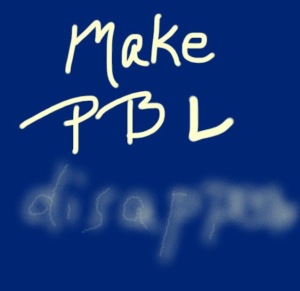…make PBL [problem based learning] disappear. In an inquiry-based school, it should be nearly indistinguishable from general instruction.
Problem based learning, inquiry based learning, question based learning… There are lots of different names for a specific type of classroom activity that places one item, image, expression, or situation in front of a group of kids and asks them to engage with it. The teacher steps back. Instruction is minimal: come up with a question, any question. That’s it. Not what type of question, not what the question needs to pertain to, not how many questions.
As a teacher, that is really hard. And it takes time to let this process happen, and, oh yeah, you need classroom rules like no judging questions, just write them down without changing them, don’t try to answer the questions, just write them down, and every question matters, so write it down even if it sounds silly or stupid.
Because when students start asking questions, curiosity is piqued.
It is okay to promise that as many questions as possible will be answered. It’s okay to go off in a direction that wasn’t in the original lesson plan. Because when students start asking questions, curiosity is piqued. And when that happens, well, all I’m sayin’ is, never underestimate curiosity!
Once students are curious, lessons can turn one of two ways; you control this knob. You can kill curiosity just as quickly as you can pique it. However, it takes courage to let this curiosity take hold, to guide it gently, and to allow the students to run with their questions.
The students have asked. The cards (one question per) are up on the board, sprinkled around the room, arranged by subject matter… However you feel they should be arranged. What next?
I like this moment. While the questions are being shared, I am gaining new insight into the minds of my charges. What do they know? What connections are being made to the image or situation or equation (not necessarily a math connection, by the way)? How do my students think? Where are the questions going to take us? And my teacherly question… Where are we in relation to the knowledge I want my students to gain from this? Will we get there, or (and this is the scary, let go and teach part) will we get somewhere else just as valuable?!
Making PBL disappear means building this type of student led inquiry into every part of the course and creating a daily attitude of curiosity.
At this point, I would take a moment to address the title of this discourse. Making PBL disappear means building this type of student led inquiry into every part of the course and creating a daily attitude of curiosity. What are we going to explore today? What are we going to learn how to do today? Students come into class prepared to ask questions, questions that they know will be answered.
This is not a pipe dream. This does take a belief on the part of the teacher that the students’ questions are worth exploring, discussing and answering. It also takes a little bit of classroom setup- students need instruction in the rules of the game and, most importantly, the focus for the lesson – that picture, equation, situation, idea – needs to be well-chosen, the possible questions and directions prepared for, and the possible math directions imagined and worked out ahead of time. This kind of lesson takes time to prepare, a commodity in short supply for most of us.
How do we get from using PBLs as sometime specials to a technically invisible way of doing business in the classroom?
The biggest thing I can say is that no teacher has to do this alone. The body of resources is growing by leaps and bounds. There are informational blogs with ideas, examples of lessons, stories of actual class experiences (some with scans of student work), videos, websites, and instructional books. There are multiple teacher groups on Twitter that share ideas and discuss lesson results. These teachers are more than willing to give feedback and help.
Having said that, integrating PBLs into the classroom requires:
1) a knowledge of the standards you want to teach, translated into “I can” statement goals,
2). A willingness to encourage student led questions and discussion,
3) A portfolio of PBL activities that cover one or more standards,
4) the ability to facilitate “what happens next” and use the questions generated by students to unwrap the ideas that will lead to understanding of the standards, AND
5) the courage to let students choose how they will investigate/learn what you are setting before them.

